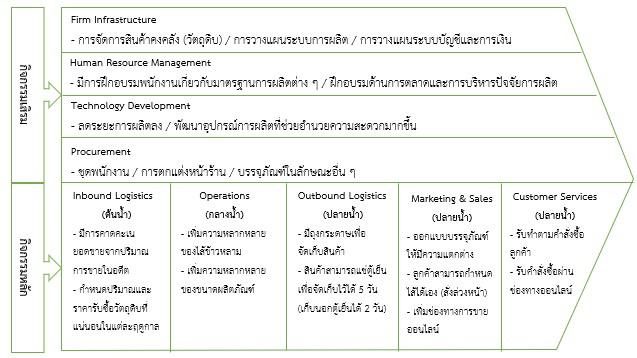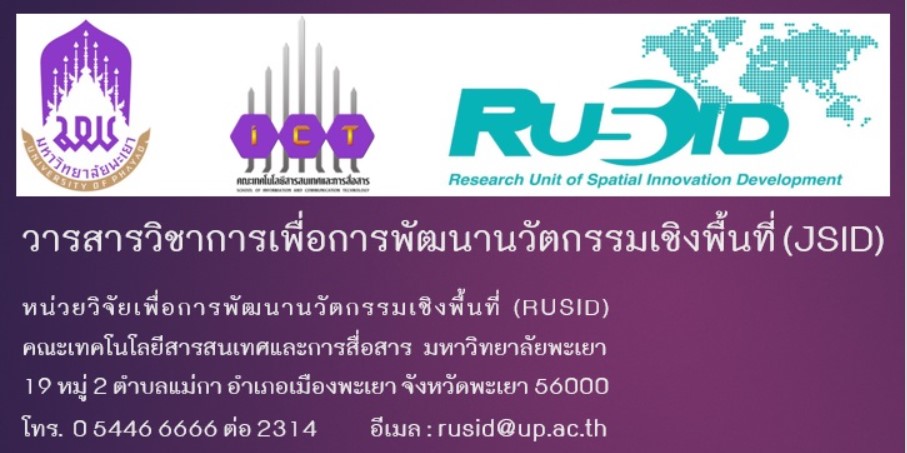การวิเคราะห์ห่วงโซ่อุปทานการท่องเที่ยวและผลิตภัณฑ์ชุมชนเพื่อพัฒนาเป็นห่วงโซ่คุณค่าใหม่และโมเดลธุรกิจที่เหมาะสมภายใต้รูปแบบชีวิตวิถีใหม่ของอำเภอพร้าว จังหวัดเชียงใหม่
คำสำคัญ:
ห่วงโซ่อุปทาน, ห่วงโซ่คุณค่า, โมเดลธุรกิจ, ชีวิตวิถีใหม่บทคัดย่อ
การวิเคราะห์ห่วงโซ่อุปทานการท่องเที่ยวและผลิตภัณฑ์ชุมชนเพื่อพัฒนาเป็นห่วงโซ่คุณค่าใหม่และโมเดลธุรกิจที่เหมาะสมภายใต้รูปแบบชีวิตวิถีใหม่ของอำเภอพร้าว จังหวัดเชียงใหม่ มีวัตถุประสงค์เพื่อวิเคราะห์ลักษณะของห่วงโซ่อุปทานการท่องเที่ยวและผลิตภัณฑ์ชุมชนในปัจจุบันของอำเภอพร้าว พัฒนาห่วงโซ่คุณค่าการท่องเที่ยวและผลิตภัณฑ์ชุมชนใหม่ของอำเภอพร้าว และสร้างโมเดลธุรกิจที่เหมาะสมภายใต้รูปแบบชีวิตวิถีใหม่ของอำเภอพร้าว จังหวัดเชียงใหม่
ผลการวิจัยพบว่าลักษณะของห่วงโซ่อุปทานการท่องเที่ยวและผลิตภัณฑ์ชุมชนในปัจจุบันของอำเภอพร้าวยังไม่ได้มีการประสานงานกับในระหว่างต้นน้ำ กลางน้ำ และปลายน้ำ รวมถึงยังขาดความเข้าใจเกี่ยวกับแนวคิดห่วงโซ่อุปทานและการดำเนินงานร่วมกันกับธุรกิจในส่วนต่าง ๆ ทำให้การดำเนินงานเป็นไปโดยมีการเชื่อมโยงระหว่างธุรกิจค่อนข้างต่ำ ในส่วนของการพัฒนาห่วงโซ่คุณค่าการท่องเที่ยวนั้น ผู้วิจัยได้นำเสนอ 7A Model เพื่อเป็นแนวทางใน
การเพิ่มมูลค่าตลอดทั้งกระบวนการท่องเที่ยว ด้านการพัฒนาห่วงโซ่คุณค่าผลิตภัณฑ์ได้ทำการศึกษาผลิตภัณฑ์ข้าวหลามแม่อ่อนศรี และได้จัดทำโมเดลห่วงโซ่คุณค่าขึ้น เพื่อนำเสนอวิธีการในการเพิ่มประสิทธิภาพของผลิตภัณฑ์จากแนวคิด Economies of Scale และผู้วิจัยได้นำเสนอโมเดลทางธุรกิจ Business Model Canvas เพื่อพัฒนา
การบริหารจัดการธุรกิจข้าวหลามให้เกิดต้นทุนที่เหมาะสม เพิ่มกำไร สร้างความพึงพอใจให้แก่ลูกค้า เพื่อให้เกิดความยั่งยืนในการทำธุรกิจ
เอกสารอ้างอิง
กระทรวงการท่องเที่ยวและกีฬา. (2560). เเผนพัฒนาการท่องเที่ยวแห่งชาติฉบับที่ 2 (พ.ศ.2560-2564). กรุงเทพฯ: สำนักงานกิจการโรงพิมพ์องค์การสงเคราะห์ทหารผ่านศึก.
กฤตพา แสนชัยธร. (2564). กลยุทธ์การจัดการโซ่อุปทาน (Strategic Supply Chain Management). ขอนแก่น: มหาวิทยาลัยขอนแก่น.
เขมิกา ธนธำรงกุล, ปรีดา ศรีนฤวรรณ, ภูษณิศา เตชเถกิง, และภัทริกา มณีพันธ์. (2563). โมเดลธุรกิจเพื่อสร้างความได้เปรียบในการแข่งขันของธุรกิจจำหน่ายเครื่องจักรกลการเกษตร ในจังหวัดเชียงใหม่. วารสารวิชาการมหาวิทยาลัยราชภัฏศรีสะเกษ, 14(2), 51 – 62.
ชุติเดช วิศาลกิตติ. (2555). การจัดการห่วงโซ่อุปทานของสินค้า ผักปลอดภัยในเขตอำเภอกำแพงแสน จังหวัดนครปฐม (บริหารธุรกิจมหาบัณฑิต). สาขาวิชาการประกอบการ, กรุงเทพฯ, มหาวิทยาลัยศิลปากร.
ทำนอง ชิดชอบ, นันทา สมเป็น, สุนิสา เยาวสกุลมาศ และประทีป ดวงแว่ว. (2557). การพัฒนาแบบจำลองโซ่อุปทานของข้าวหอมมะลิอินทรีย์ในประเทศไทย. แก่นเกษตร, 42(ฉบับพิเศษ 2), 243-249.
ธนพัฒน์ จงมีสุข. (2563). นโยบายการจัดการห่วงโซ่อุปทานข้าวหอมมะลิ ทุ่งกุลาร้องไห้. มนุษย์สังคมสาร, 18(1), 127-146.
บดินทร์ ชาตะเวที. (2563). พฤติกรรมกับชีวิตวิถีใหม่: New Normal. จาก http://www.ttmed.psu.ac.th/258.
ประจวบ กล่อมจิตร. (2564). โลจิสติกส์-โซ่อุปทาน: การออกแบบและจัดการเบื้องต้น. กรุงเทพฯ: ซีเอ็ดยูเคชั่น.
รามณรงค์ นิลกำแหง และกันฑิมาลย์ จินดาประเสริฐ. (2566). ห่วงโซ่อุปทานการท่องเที่ยวเชิงอาหารในประเทศไทยหลังยุคโควิด-19. วารสารศิลปะศาสตร์ราชมงคลสุวรรณภูมิ, 5(2), 462-476.
สไบทิพย์ มงคลนิมิตร์, จิรัชญา โชติโสภานนท์ และพณกฤษ อุดมกิตติ. (2563). การยกระดับห่วงโซ่คุณค่าการท่องเที่ยวเชิงประสบการณ์ท้องถิ่น กรณีศึกษา เส้นทางพื้นที่ต้นแบบจังหวัดสุโขทัย. วารสารวิชาการการท่องเที่ยวไทยนานาชาติ, 16(1), 57-80.
สิริมา ศรีสวัสดิ์ และเดชรัตน์ สัมฤทธิ์. (2565). การตัดเลือกและการจัดลำดับความสำคัญของปัจจัยเสี่ยงบนห่วงโซ่อุปทานในอุตสาหกรรมปลาทูน่าประเทศไทยภายใต้สภาพแวดล้อมที่คลุมเครือ. วารสารปัญญาภิวัฒน์, 4(2), 104-117.
สุริยนต์ สูงคำ และลัดดา ปินตา. (2565). การจัดการห่วงโซ่อุปทานสินค้าเกษตรปลอดภัยของบริษัท เชียงใหม่วิสาหกิจเพื่อสังคม จำกัด. วารสารบริหารธุรกิจและศิลปะศาสตร์ราชมงคลล้านนา, 10(2), 1-18.
สิริลักษณ์ พานุช. (2564). รูปแบบฐานวิถีชีวิตใหม่ในการเลือกซื้ออาหารของผู้บริโภค ในเขตกรุงเทพมหานคร ภายหลังสถานการณ์ระบาดของโรคติดเชื้อไวรัสโคโรนาสายพันธุ์ใหม่ 2019 (COVID-19). วารสารวิชาการบัณฑิตศึกษาและสังคมศาสตร์ มหาวิทยาลัยราชภัฏอุตรดิตถ์, 11(1), 87-98.
อภิชาต ดะลุณเพธย์. (2556). การเพิ่มประสิทธิภาพการจัดการโซ่อุปทานและโลจิสติกส์ของลิ้นจี่ (รายงานการวิจัย). กรุงเทพฯ: มหาวิทยาลัยเกษตรศาสตร์.
ACS. (2562). การจัดการห่วงโซ่อุปทานคืออะไรและเหตุใดจึงสำคัญ. จาก https://acsregistrars-thai.com/การจัดการห่วงโซ่อุปทาน-s/.
Bueno, R. A., Urbistondo, A. P. and Martinez, A. B. (2020). The MICE tourism value chain: Proposal of a conceptual framework and analysis of disintermediation. Journal of Convention & Event Tourism, 21(3), 177-200.
Hialager, A. M., Tervo-Kankare, K. and Tuohino, A. (2016). Tourism value chains revised and applied to rural well-being tourism. Tourism Planning & Development, 13(4), 379-395.
Nhamo, G., Dube, K. and Chikodzi, D. (2020). Global Tourism Value Chains, Sustainable Development Goals and COVID-19. Counting the Cost of COVID-19 on the Global Tourism Industry. Cham: Springer.
Osterwalder, A. and Pigneur, Y. (2010). Business Model Generation: A Handbook for Visionaries, Game Changers, and Challengers. New Jersey: John Wiley & Sons.
Porter, M. E. (2004). Competitive Advantage: Creating and Sustaining Superior Performance. New York: Simon & Schuster.
Rahmiati, F., Othman, A. N., Ismail, Y., Bakri, H. M. and Amin, G. (2020). The Analysis of Tourism Value Chain Activities on Competitive Creation: Tourists Perspective. Talent Development & Excellent, 12(1), 4613-4628.





